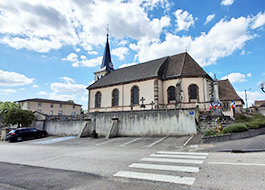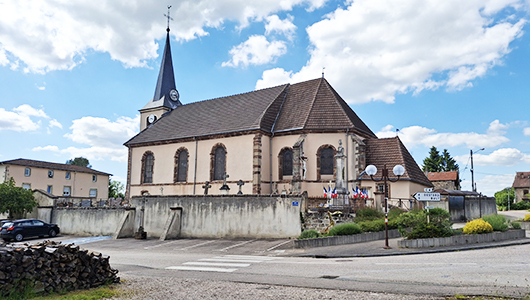Sainte-Hélène
Durée visite à pied : 5 minutes
Durée visite à vélo : 5 minutes
En 1178, le nom de la commune est attesté sous les formes Parroch Sanctę Elenę. Sainte-Hélène est un hagiotoponyme qui fait référence à Hélène, mère de l’empereur Constantin. Le village dépendait de l’abbesse d’Epinal. Peuplée de nos jours par 466 habitants, Sainte-Hélène en comptait environ 570 lorsque naquit le plus célèbre de ses enfants. Charles-André Balland est né ici le 15 février 1761. Quand la Révolution éclate, il est curateur au bailliage de Bruyères. En 1791, il est suppléant de François de Neufchâteau, élu député à l’Assemblée législative. En 1792, celui-ci refuse de siéger à la Convention, invoquant des problèmes de santé. Balland monte à Paris pour le remplacer. Lors du procès de Louis XVI, à la question posée sur la mort du roi, il fait une réponse embrouillée mais prudente et ne vote pas la peine capitale, déclarant : « Je vote, quant à présent pour sa détention, sauf à bannir ou à le faire mourir, si le peuple le veut » Son action politique est si modeste, qu’un observateur écrira de lui « Membre de la convention, il fit partie de cette assemblée, à peu près comme le grain de sable fait partie du rivage » Entré à la commission des finances, ses efforts visent à diminuer la masse des assignats en circulation, ainsi que le prix des denrées et des marchandises. Sous le Directoire, Balland est élu au Conseil des Cinq-Cents. Il intègre une fois encore la commission des finances. Il meurt à Paris en 1810. Précisons que Napoléon n’a jamais mis les pieds dans cette Sainte-Hélène là !
In 1178, the name of the commune is attested in the form Parroch Sanctę Elenę. Sainte-Hélène is a hagiotoponym that refers to Helen, mother of Emperor Constantine. The village depended on the abbess of Epinal. Nowadays populated by 466 inhabitants, Sainte-Hélène had around 570 when the most famous of her children was born. Charles-André Balland was born here on February 15, 1761. When the Revolution broke out, he was curator in the bailiwick of Bruyères. In 1791, he was deputy to François de Neufchâteau, elected deputy to the Legislative Assembly. In 1792, François de Neufchâteau refused to sit in the Convention, citing health problems. Balland went to Paris to replace him. During the trial of Louis XVI, when asked about the king’s death, he gave a confused but cautious answer and did not vote for the death penalty, declaring: « I vote, for the present, for his detention, except to banish or put him to death, if the people so wish. » His political action was so modest that one observer wrote of him: « As a member of the convention, he was part of this assembly, much as a grain of sand is part of the shore. » A member of the finance commission, his efforts aimed to reduce the mass of assignats in circulation, as well as the price of foodstuffs and goods. Under the Directory, Balland was elected to the Council of Five Hundred. He once again joined the finance commission. He died in Paris in 1810. Napoleon set never foot on that Saint Helena!
Im Jahr 1178 wurde der Name der Gemeinde in der Form Parroch Sanctę Elenę (Heiliger Pfarrer) erwähnt. Sainte-Hélène ist ein Hagiotoponym, das sich auf Helena, die Mutter Kaiser Konstantins, bezieht. Das Dorf unterstand der Äbtissin von Épinal. Heute hat Sainte-Hélène 466 Einwohner, als ihr berühmtestes Kind geboren wurde, waren es rund 570. Charles-André Balland wurde hier am 15. Februar 1761 geboren. Bei Ausbruch der Französischen Revolution war er Kurator im Vogteiamt Bruyères. 1791 wurde er Stellvertreter von François de Neufchâteau, der zum Abgeordneten der gesetzgebenden Versammlung gewählt wurde. 1792 weigerte sich François de Neufchâteau mit gesundheitlichen Gründen, am Konvent teilzunehmen. Balland ging nach Paris, um ihn zu ersetzen. Während des Prozesses gegen Ludwig XVI. gab er auf die Frage nach dem Tod des Königs eine verwirrte, aber vorsichtige Antwort und stimmte nicht für die Todesstrafe. Er erklärte: „Ich stimme vorerst für seine Inhaftierung, außer für seine Verbannung oder Hinrichtung, wenn das Volk es wünscht.“ Sein politisches Engagement war so bescheiden, dass ein Beobachter über ihn schrieb: „Als Mitglied des Konvents war er Teil dieser Versammlung wie ein Sandkorn zum Strand.“ Als Mitglied der Finanzkommission zielte er darauf ab, die Menge der im Umlauf befindlichen Assignaten sowie die Preise für Lebensmittel und Waren zu senken. Auf Geheiß des Direktoriums wurde Balland in den Rat der Fünfhundert gewählt. Er gehörte erneut der Finanzkommission an. Er starb 1810 in Paris. Napoleon hingegen betrat nie St. Helena!
Les points de visites

.
L’ancienne église Saint-Georges datait du XVIe siècle. Elle fut incendiée et détruite pendant la guerre de Trente Ans. Reconstruite vers 1753, elle a été restaurée de 1854 à 1870. Lors de la cérémonie du centenaire de l’Armistice du 11 novembre 1918, une de ses cloches datant de 1771 s’est fissurée. La Fondation du patrimoine a participé au financement des travaux de restauration. Cette cloche baptisée « Hélène » pèse 600 kg. Elle a été réalisée par l’entreprise Voegelé en 2023. A voir au pied des murs extérieurs, les tombes de plusieurs prêtres de la paroisse, dont deux frères. A l’intérieur on peut découvrir des vitraux du XVIe siècle, rescapés de l’incendie, un groupe sculpté de la Sainte Famille, un autre représentant la Vierge et Jésus Enfant. Le maître-autel serait l’œuvre d’un artisan de Saint-Gorgon.
The old Saint-Georges church dates back to the 16th century. It burned down and was destroyed during the Thirty Years’ War. Rebuilt around 1753, it was restored from 1854 to 1870. During the Armistice centenary ceremony on November 11, 1918, one of its bells dating from 1771 cracked. The Heritage Foundation helped finance the restoration work. This bell, named « Hélène, » weighs 600 kg. It was made by the Voegelé company in 2023. At the foot of the exterior walls, you can see the tombs of several parish priests, including two brothers. Inside, you can discover 16th-century stained-glass windows that survived the fire, a sculpted group of the Holy Family, and another representing the Virgin and Child Jesus. The high altar is said to be the work of a craftsman from Saint-Gorgon.
Die alte Kirche Saint-Georges stammt aus dem 16. Jahrhundert. Sie brannte nieder und wurde im Dreißigjährigen Krieg zerstört. Um 1753 wiederaufgebaut, wurde sie von 1854 bis 1870 restauriert. Bei der Hundertjahrfeier des Waffenstillstands am 11. November 1918 zerbrach eine ihrer Glocken aus dem Jahr 1771. Die Stiftung für Kulturerbe unterstützte die Finanzierung der Restaurierungsarbeiten. Diese Glocke mit dem Namen „Hélène“ wiegt 600 kg. Sie wurde 2023 von der Firma Voegelé hergestellt. Am Fuße der Außenmauern befinden sich die Gräber mehrerer Pfarrer, darunter zweier Brüder. Im Inneren können Sie Buntglasfenster aus dem 16. Jahrhundert entdecken, die den Brand überstanden haben, eine Skulpturengruppe der Heiligen Familie und eine weitere, die die Jungfrau mit dem Jesuskind darstellt. Der Hochaltar soll das Werk eines Handwerkers aus Saint-Gorgon sein.
.





